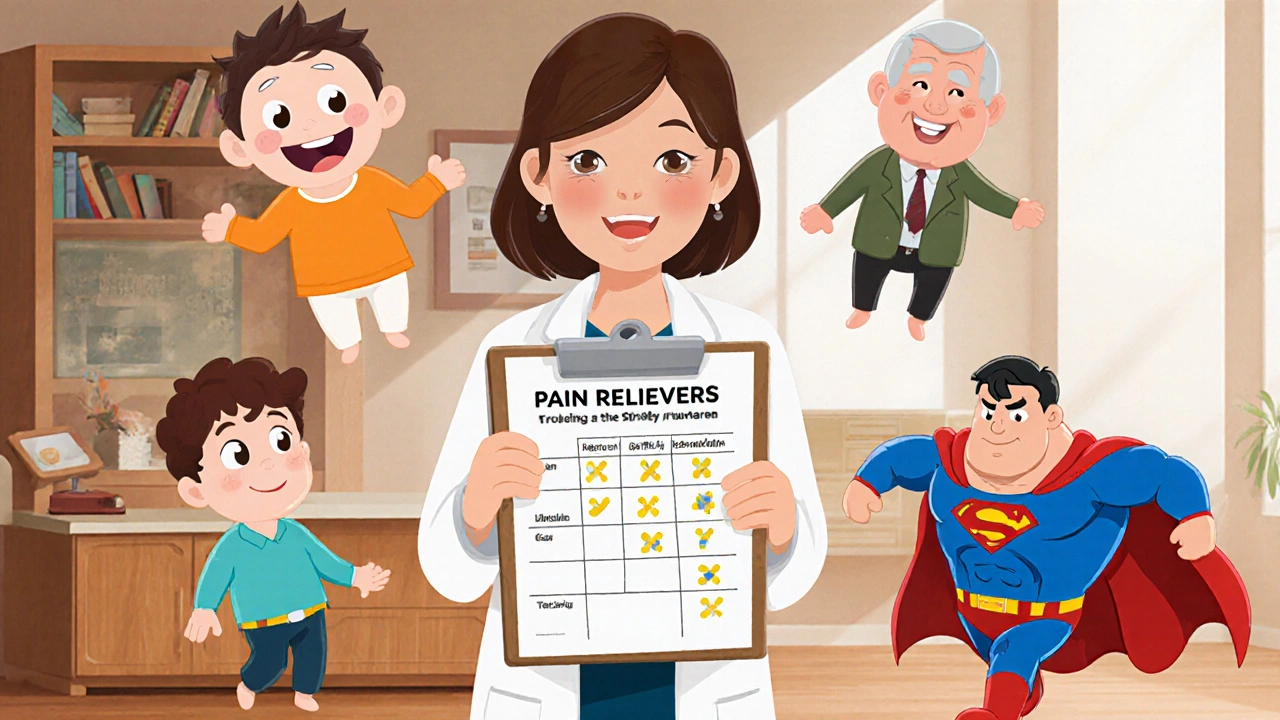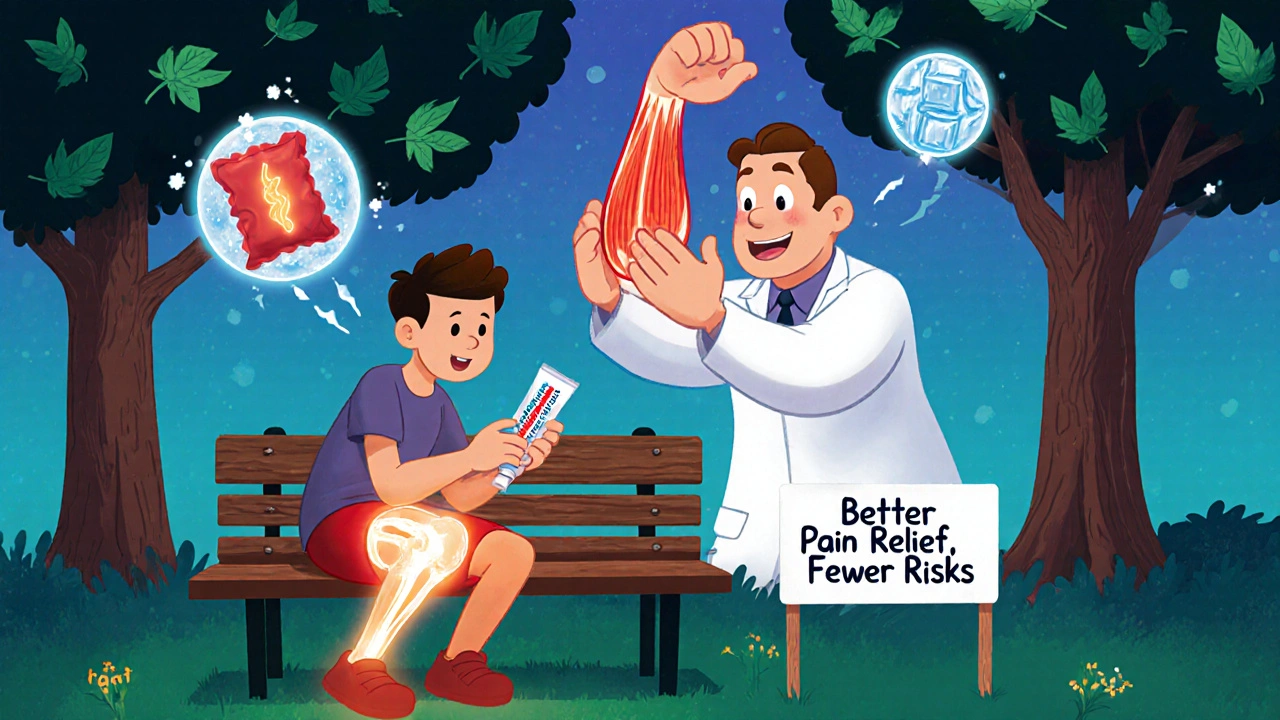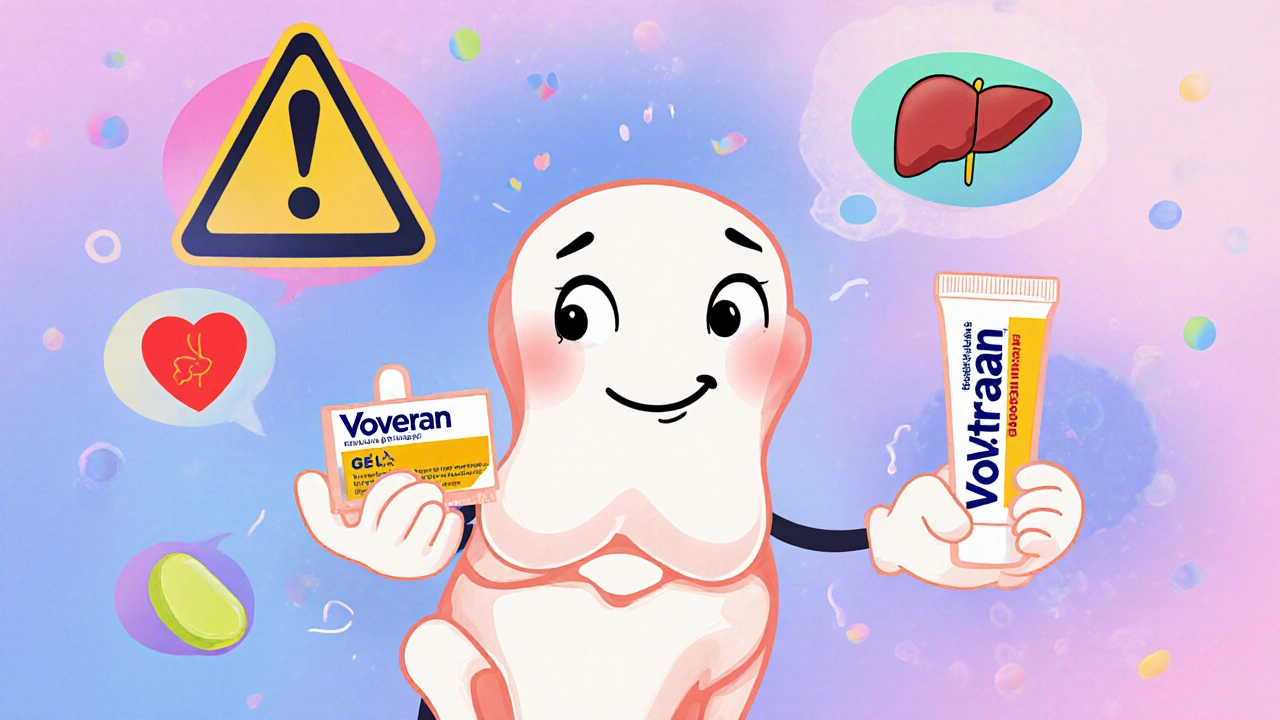Pain Relief Option Selector
Find Your Best Pain Relief Option
Answer a few questions about your condition to discover the safest and most effective pain relief option for you.
If you've been prescribed Voveran for pain or inflammation, you're not alone. But you might be wondering: is this the best option for you? Or are there other pills, gels, or treatments that work just as well - maybe even better - without the same side effects? Let’s cut through the noise and compare Voveran to its most common alternatives, based on real-world use, effectiveness, and safety.
What is Voveran?
Voveran is a brand name for diclofenac sodium, a nonsteroidal anti-inflammatory drug (NSAID) used to treat pain, swelling, and stiffness from conditions like arthritis, muscle injuries, and post-surgical inflammation. It’s available as tablets, capsules, gels, and injections. Most people take it for short-term relief, but some use it long-term for chronic conditions.
How does it work? Diclofenac blocks enzymes called COX-1 and COX-2, which produce prostaglandins - chemicals that cause pain and swelling. It’s fast-acting, often working within 30 minutes to an hour. For many, it’s a go-to when ibuprofen doesn’t cut it.
Common Alternatives to Voveran
There are several other NSAIDs and pain relievers that doctors prescribe when Voveran isn’t suitable. Here are the top five you’re likely to hear about.
1. Ibuprofen (Advil, Motrin)
Ibuprofen is the most widely used NSAID in the world. It’s available over the counter and is often the first choice for mild to moderate pain - headaches, menstrual cramps, sprains.
Compared to Voveran, ibuprofen is gentler on the stomach and has a lower risk of serious side effects like ulcers or heart problems. But it’s also less potent. If you have severe joint pain or inflammation from rheumatoid arthritis, ibuprofen might not be enough.
2. Naproxen (Aleve, Naprosyn)
Naproxen lasts longer than Voveran - up to 12 hours per dose - which means fewer pills throughout the day. It’s also stronger than ibuprofen and often used for chronic conditions like osteoarthritis.
Studies show naproxen has a slightly lower risk of heart attack than diclofenac (Voveran’s active ingredient). That’s why some doctors prefer it for patients with cardiovascular concerns. But like all NSAIDs, it can still cause stomach bleeding if taken daily for months.
3. Celecoxib (Celebrex)
Celecoxib is a COX-2 inhibitor. That means it targets only the COX-2 enzyme, which is linked to inflammation - not COX-1, which protects the stomach lining. This makes it easier on the gut.
It’s often prescribed to people who need long-term pain control but have a history of stomach ulcers. But celecoxib isn’t risk-free. It carries a black box warning from the FDA for increased heart attack and stroke risk, especially at high doses or with long-term use.
4. Acetaminophen (Tylenol)
Acetaminophen isn’t an NSAID. It doesn’t reduce inflammation - only pain and fever. So if you have swollen knees from arthritis, it won’t fix the swelling. But it’s very effective for pain alone.
It’s safer for the stomach and heart than Voveran. People with high blood pressure, kidney disease, or a history of GI bleeding often switch to acetaminophen. The catch? It’s hard on the liver. Taking more than 3,000 mg a day - especially with alcohol - can cause serious liver damage.
5. Topical NSAIDs (Voltaren Gel, Diclofenac Gel)
If you’re taking Voveran pills and getting stomach upset, you might benefit from a topical version. Voltaren Gel (also diclofenac) delivers the same active ingredient directly to the skin over sore joints.
Studies show topical diclofenac works just as well as oral Voveran for knee and hand osteoarthritis - but with far fewer side effects. Less than 6% of the drug enters your bloodstream, so your stomach and heart are mostly spared.
Side Effects: What You’re Really Risking
Every painkiller has trade-offs. Here’s how Voveran stacks up against its rivals in real-world safety.
| Side Effect | Voveran (Diclofenac) | Ibuprofen | Naproxen | Celecoxib | Acetaminophen |
|---|---|---|---|---|---|
| Stomach ulcers or bleeding | High risk | Moderate risk | Moderate risk | Low risk | Very low risk |
| High blood pressure | Common | Mild increase | Mild increase | Common | No effect |
| Heart attack or stroke risk | Higher than most NSAIDs | Low to moderate | Lower than diclofenac | Higher (black box warning) | No increased risk |
| Kidney damage (long-term use) | Yes | Yes | Yes | Yes | Yes (at high doses) |
| Liver damage | Rare | Rare | Rare | Rare | High risk if misused |
Bottom line: Voveran is among the most potent NSAIDs - but also among the riskiest for your heart and stomach. If you’re healthy and young, short-term use is usually fine. If you’re over 60, have high blood pressure, or take blood thinners, you need to be much more careful.

When to Choose Voveran Over Others
There are still times when Voveran is the best choice.
- You have severe joint inflammation that ibuprofen or naproxen can’t control.
- You’ve tried other NSAIDs and they didn’t help.
- You need fast relief - Voveran kicks in quicker than naproxen.
- You’re using the topical gel version and want targeted relief without system-wide side effects.
Many physical therapists and orthopedic doctors still recommend Voveran for acute flare-ups of arthritis or back pain - especially when combined with physical therapy or ice.
When to Avoid Voveran
Don’t take Voveran if you:
- Have had a stomach ulcer or GI bleeding in the past
- Have heart disease, heart failure, or high blood pressure
- Are over 65 (higher risk of kidney and stomach issues)
- Take blood thinners like warfarin or aspirin
- Are pregnant (especially after 20 weeks)
- Have asthma triggered by NSAIDs
If any of these apply to you, talk to your doctor about acetaminophen, topical gels, or even non-drug options like physical therapy, heat therapy, or weight management.

Non-Drug Alternatives That Actually Work
Medication isn’t the only way to manage pain. For many people, combining drugs with lifestyle changes cuts the need for pills.
- Physical therapy: Strengthening muscles around sore joints reduces pressure and pain. Studies show it’s as effective as NSAIDs for knee osteoarthritis.
- Weight loss: Losing just 10 pounds can cut knee pain by 50% in overweight people.
- Heat and cold therapy: Ice reduces swelling after injury. Heat relaxes stiff muscles.
- Topical capsaicin cream: Made from chili peppers, it blocks pain signals. Works well for nerve pain or arthritis.
- Acupuncture: Some clinical trials show it reduces chronic back and knee pain better than placebo.
These aren’t magic fixes - but they’re safe, low-cost, and work well alongside or instead of drugs.
What Doctors Really Recommend
Based on guidelines from the American College of Rheumatology and the UK’s NICE, here’s what most doctors do in practice:
- Start with acetaminophen for mild pain without swelling.
- If inflammation is present, try topical NSAID gel first - especially for knees or hands.
- If that’s not enough, try naproxen over diclofenac (Voveran) for better heart safety.
- Only use oral diclofenac (Voveran) if other options fail - and use the lowest dose for the shortest time.
- Always add a stomach-protecting drug like omeprazole if you’re on long-term NSAIDs.
That’s why more people are switching from Voveran tablets to Voltaren Gel - it gives the same pain relief with 90% fewer side effects.
Final Takeaway
Voveran works - fast and strong. But it’s not the safest NSAID out there. For most people, especially those with heart risks or stomach sensitivity, naproxen or topical diclofenac are better choices. Acetaminophen is the go-to for simple pain without inflammation.
Don’t assume the strongest pill is the best one. The best painkiller is the one that works for you - with the least risk.
If you’re on Voveran long-term, ask your doctor: "Is this still the right choice?" There’s a good chance a safer, equally effective option exists.
Is Voveran stronger than ibuprofen?
Yes, Voveran (diclofenac) is generally stronger than ibuprofen for inflammation and pain relief. It’s often prescribed when ibuprofen doesn’t help enough - especially for arthritis or severe muscle injuries. But that extra strength comes with higher risks to your stomach and heart.
Can I take Voveran and acetaminophen together?
Yes, many people take them together safely. Voveran reduces inflammation, while acetaminophen tackles pain and fever. This combo is common for post-surgery or severe arthritis pain. Just make sure you don’t exceed 3,000 mg of acetaminophen per day and avoid alcohol.
Is Voltaren Gel the same as Voveran?
Yes - Voltaren Gel contains the same active ingredient as Voveran: diclofenac. The difference is how it’s delivered. Voltaren Gel is applied to the skin, so it targets pain locally with far less risk to your stomach or heart. It’s often preferred for joint pain in the knees, hands, or elbows.
What’s the safest NSAID for long-term use?
Naproxen is generally considered the safest NSAID for long-term use, especially for people with heart concerns. It has a lower risk of heart attack than diclofenac (Voveran). But no NSAID is completely safe long-term. Always use the lowest effective dose and talk to your doctor regularly.
Can I stop Voveran suddenly?
Yes, you can stop Voveran suddenly if you’re using it for short-term pain like a sprain or headache. But if you’ve been taking it daily for weeks or months for chronic pain (like arthritis), don’t stop without talking to your doctor. Abruptly stopping might cause rebound pain or make inflammation worse. Your doctor may recommend tapering off slowly.


Donna Hinkson
November 2, 2025
I switched from Voveran to the topical gel after my stomach started acting up. Honestly? Best decision ever. No more bloating, no more midnight acid reflux. Same pain relief, just without the internal chaos. I wish I’d tried it sooner.
Also, my PT told me to pair it with daily calf stretches for knee pain. Crazy how much that helped. Pills aren’t the only answer.
HALEY BERGSTROM-BORINS
November 3, 2025
EVERYONE knows Big Pharma pushed diclofenac hard because it’s profitable. 🤫 The FDA’s ‘black box warning’? That’s just the tip of the iceberg. They’re hiding how much it messes with your mitochondria. Google ‘diclofenac mitochondrial toxicity’ - they don’t want you to find that.
Also, acetaminophen is just slow poison for your liver. They’re all evil. 💉☠️
Dr. Marie White
November 3, 2025
Interesting breakdown - especially the comparison of cardiovascular risks. I’ve been on naproxen for years because of my hypertension, and my cardiologist always says it’s the ‘least worst’ NSAID. But I’m curious: are there any recent studies comparing long-term renal outcomes between naproxen and diclofenac in patients over 70?
Also, the data on topical diclofenac is promising, but I’ve noticed it doesn’t help much with hip pain. Is that just me, or is there a biomechanical reason?
Wendy Tharp
November 4, 2025
Wow. Someone actually wrote a responsible article. Who let this happen? 😏
Let’s be real - if you’re taking any NSAID long-term, you’re just gambling with your organs. Voveran? That’s just a fancy name for a slow suicide pill. And don’t even get me started on ‘physical therapy’ - that’s just a $100/hour placebo with stretchy bands.
Take Tylenol. Or don’t take anything. Just lie on the floor and pray. That’s what I do.
Also, your doctor doesn’t know better. They’re paid by the drug reps. 💅
Subham Das
November 5, 2025
Ah, the modern pharmacological paradox - we seek to eliminate suffering, yet in doing so, we fracture the very biological harmony that birthed pain as a sacred messenger. Diclofenac, this chemical titan of the industrial age, is not merely a drug - it is a metaphysical rebellion against the body’s innate wisdom.
When you silence inflammation with synthetic COX inhibitors, you do not heal - you suppress. You become a prisoner of the pharmaceutical-industrial complex, mistaking symptom management for cure. The ancient sages of Ayurveda knew: pain is not the enemy. It is the messenger. And we, in our hubris, have silenced the messenger and blamed the message.
Topical gels? Still an external bandage on a soul crying out for balance. True relief lies in pranayama, turmeric paste, and the quiet surrender to the rhythm of nature - not in pill bottles stamped with corporate logos.
And yet… I still take naproxen on Tuesdays. Irony is the price of living in a broken world. 🌿
Cori Azbill
November 7, 2025
USA: 1. NSAID safety guidelines. Rest of the world: 0. Why does everyone else get to use safer drugs while we’re stuck with Voveran because the FDA is asleep at the wheel?
Also, why is Voltaren Gel cheaper in Canada? Coincidence? I think not. 🇺🇸💀
And yes, I’ve seen the studies. The ones that say naproxen is safer? Paid for by AstraZeneca. Don’t believe the hype. Just take ibuprofen and pray.
Paul Orozco
November 8, 2025
Okay, but who actually reads all this? No one. Everyone just takes whatever their doctor hands them and Googles ‘is diclofenac killing me?’ at 3 a.m.
I’ve been on Voveran for 8 months. My stomach feels like a warzone. My doctor said ‘it’s fine.’ My wife says I’m turning into a grumpy zombie. I’m just waiting for the other shoe to drop.
Also, why does every article on pain meds sound like a textbook? Can we just say it like it is? This stuff is dangerous. And nobody’s talking about the real cost - your quality of life.
Bobby Marshall
November 8, 2025
Man, this post is the real deal. No fluff, no hype - just straight-up facts with a side of common sense.
I used to be a Voveran junkie after my back surgery. Then I tried the gel + daily walks + ice packs. Didn’t feel like a superhero, but I stopped feeling like I was being stabbed every time I stood up.
Also, I swear by that capsaicin cream. Burns like hell at first, but then? Magic. Like your nerves are getting a massage from a chili pepper.
Don’t let the strongest pill win. Sometimes the quietest fix is the one that keeps you alive.
And hey - if you’re reading this and on Voveran long-term? Ask your doc about naproxen. Seriously. It might save your heart.